H eading into 2023, the signs of progress that appeared over the past year continue to blossom. The organizations that have made it through recent and ongoing turmoil are using their newfound resilience as a springboard into the future. The return to strategy predicted by CompTIA’s IT Industry Outlook 2022 has become a reality for many organizations, and they are now focused on writing their next chapter.
Those new chapters hold a tremendous amount of potential. Spurred by global events, companies may decide to focus more effort on improving the world around them. There are clearly big problems to solve; what may be less clear is that many solutions already have good momentum. According to the 2022 Goalkeepers report from the Gates Foundation, the percentage of the global population living below the international poverty line has fallen by nearly 20% since 2015, and the rate of mortality for children under 5 has fallen by more than 50% since 1990. Organizations that choose to make an impact on social issues can help drive greater improvement.
Closer to home, there is potential for individual company growth. The modern business world is far less constrained by geographic reach, financial backing or language barriers. Organizations have more opportunities than ever to diversify their workforce, reach new customers and develop new products. Whether it is expanding current offerings or pivoting to a new business model, companies can build on lessons learned to reach new heights.
No matter which direction an organization may choose, technology will play a starring role in the story. Technology alone cannot solve all the world’s problems, but it can accelerate solutions for those with the right vision. The technology industry may face future headwinds around ethical concerns or regulatory maneuvering, but there is no doubt that those hoping to make a difference can use technology to unlock the potential they imagine.
If the pandemic has taught today’s businesses anything (besides the fragility of life), it’s that anything can happen in an instant. Scarce employees, business closures, societal lockdowns, remote work, the inability to source goods, you name it. Seismic shifts are real. But do they last when the crisis abates? That’s a fair question as we make our way into 2023, one to which the answer is becoming increasingly clear: Business as usual is no more. In fact, doing things as we always have may no longer be the safe option, even for companies that are content with flat or minimal growth. Many technology businesses will have to leave their comfort zone to thrive. This means a deep navel gaze at current operations, sales and marketing, human resources, and strategic innovation efforts.
Why? First off, customers are evolving. While they are as enthusiastic as ever about the role technology plays in their success, they are also much more scrutinous and demanding in their tech journey. With many of their own businesses in flux, customers are taking a hard look at ROI on every potential tech purchase. Which means, if you sell technology, the ability to convincingly make a specific business case for every product or service is not just a nice sales differentiator anymore, it’s essential. Customers are also more tech-savvy, so the bar is higher for what they expect from providers. If basic security is all you offer as an MSP today, for example, it may no longer cut it as data breach-nervous customers seek an expert with more sophisticated skills.
The same goes for improving other tech, sales and marketing skills, or pursuing a business model that more aligns with how today’s customers prefer to engage in the digital economy. So, if this means blowing up that finely optimized managed services stack you’ve been working on since 2018, so be it. Just as customers in 2023 will be scrutinizing operations, purchasing and people, so too should their tech providers. It’s business as usual – no more.
You can’t talk about toppling business as usual without discussing the workforce. As tech companies in 2023 continue to face immense talent acquisition and retention challenges, they do so in an environment where the worker-employer dynamic is no longer completely recognizable. Remote work flexibility, the Great Resignation, quiet quitting – the headlines are relentless. The coming year is going to test employers greatly as they aim to fill positions with workers skilled in a host of new and emerging tech disciplines and support roles, while balancing two other things: Empowered and/or elusive job applicants and macroeconomic uncertainty. Ironically, the two just might be mutually exclusive. As an employer, which do you prefer: A hard-to-fill staffing pipeline and new employee demands or a recession that throws the hiring picture into tumult? For now, let’s set aside recession since it’s largely uncontrollable, and focus on the changing workforce picture. Post-pandemic worker empowerment is a thing that’s likely here to stay to some degree or another.
As we enter 2023, businesses will need to settle on what kind of flexibility and culture they are going to have, debating things like remote work as an absolute employee choice, a hybrid option or something more restrictive. Part of that decision will hinge on the productivity and performance of workers, which is gaining renewed attention today as employers grapple with ways to measure staff output and quality in a decentralized, virtual work environment. At this point, it is looking as if remote work and flex time will not be an all-or-nothing proposition for most tech companies and channel firms; hybrid situations will rule. Recruitment and hiring practices are another evolving area as companies seek to fill coveted roles in data, cybersecurity, cloud, metaverse and other disciplines with highly capable candidates with both technical acumen and durable skills. As part of this mandate, looking outside the traditional box for new workers will accelerate as a trend. That means emphasizing diversity, equity and inclusion (DEI) efforts and recruitment, dropping the longstanding four-year college degree requirement for many positions, and focusing on upskilling and on-the-job training and certification for existing employees.
Lastly, but not least, the topic of mental health among tech industry workers will not diminish in 2023. Companies will need to recognize the mental health issue and its prevalence, create an environment that helps to minimize its toll on workers and, when needed, provide flexibility and support for employees who seek help.
The technology trend that has captured the most headlines over the past year has almost certainly been the metaverse. A quick review of trending search terms shows that after a huge spike in interest around the time Facebook rebranded as Meta, metaverse has maintained a slight lead or stayed on pace with other emerging topics, such as artificial intelligence or blockchain. With all the focus, though, the big question has been: What exactly does the metaverse represent?
The first impression most people have is a virtual reality experience complete with legless avatars, but there’s something larger at play. CompTIA has previously made the point that in the broadest sense, the metaverse simply represents online life. This means we’ve been living in the metaverse for quite a while now. If that’s the case, virtual reality (VR) does not necessarily represent the next plateau of online life for everyone, but instead represents a compelling new option for digital interactions. Instead of viewing the metaverse as a new VR-based phase of the internet, it might be more accurate to view it as an extension of omnichannel customer experiences. A similar take on the situation comes from Tim O’Reilly, who has argued that the metaverse is a vector of digital connection and community, and recent trends such as increased Zoom adoption or greater utilization of recorded video have driven progress on that vector.
Virtual reality adds an even greater degree of immersion, but there are ultimately a limited number of applications where that level of immersion pays off. As organizations consider how to build their own metaverse for their customers, there will be less focus on headsets and virtual real estate and more focus on building depth in customer relationships and creating connections between the many digital experiences a customer might choose.
If the metaverse has been the trend dominating headlines, cloud computing has been the trend with the most impact on current IT activities. Acceleration in cloud adoption has led to most organizations taking on a cloud-first approach, where cloud platforms are the first choice for IT system and applications, and exceptions are made on a case-by-case basis for reasons of critical security or unique finances. This shift to a cloud-first mentality has basically brought an end to the first stage of mass cloud adoption. In that early stage, the focus was on the technical challenges of migrating individual systems, the lessons learned about closing cybersecurity gaps with a cloud provider and the basic concepts of integrating different cloud and on-prem components.
The next stage of adoption will focus on the steps organizations now need to take to handle complexity in a multi-cloud environment. First, there will be a greater demand for orchestration, as low barriers to entry have allowed different departments to pursue their own cloud solutions. This distributed approach to technology procurement has created flexibility while also creating a management headache. Someone – most likely someone on an IT infrastructure team – now needs to oversee the big picture across the organization.
The second step is closely related. The primary impact of cloud sprawl is escalating cost, and the growing field of FinOps addresses the intersection of finance and IT operations. Just as DevOps demands expertise in both development and infrastructure to make software cycles more efficient, FinOps demands both technical knowledge and financial acumen to fine-tune cost structures while maintaining a robust and flexible cloud architecture. As the lines between business and IT get more and more blurred, these new activities will help organizations control their cloud activity and open new pathways for IT professionals.
Whether it’s psychologist Barry Schwartz in his book, “Paradox of Choice, Why More is Less,” or Malcolm Gladwell’s Ted Talk anecdote on 36 different spaghetti sauces in the grocery store, the topic of choice – too much, how many, good, bad or otherwise – elicits endless discussion. Look at the tech landscape, where the past 15 years or so have ushered in a period of choice explosion and decision fatigue. More vendors, more technologies, more partners, more business models, more relationships – it's dizzying. And it’s not always what you think.
Consider the plethora of new companies that have emerged around the as-as-service model for software, for example. For many channel firms, the availability of so many new vendors to choose from has unshackled them from complete reliance on the traditional behemoths in the industry and enabled them to explore new markets around emerging technologies. This is a good thing. Yet, those same channel firms have found that newer SaaS vendors are also green when it comes to the indirect model. Unlike the establishment, the new wave doesn’t know its way around setting up a partner program, benefits, compensation, enablement and support for their ecosystem. That’s not a good thing.
In the year ahead, the expanding vendor landscape is going to prod both new and established players to up their game to stand out among the rest. Greater choice and the ubiquity of technology will also have an impact on established business practices across the digital economy. Take the agricultural industry and a company like John Deere, for example. John Deere, which already owns the lion’s share of the $68B U.S. market for farm equipment sales, has built up its internal software acumen impressively by outfitting its autonomous farm vehicles with all manner of modern features and capabilities that are changing the industry. This seems like a good thing, a nice example of the democratization of technology beyond the domain of the tech industry. And yet, John Deere’s skill with technology is wreaking havoc on an entire network of independent equipment repair dealers that farmers have used for generations to fix their stuff. In effect, technology’s expansion to a non-tech industry, in this case John Deere, is restricting choice downstream to customers (the farmers). At the same time though, it is ushering in a subscription-based model for farm equipment repair that might, in the long run, be preferable. This is the choice conundrum that technology can impose and one that will only escalate in the year ahead and beyond.
Operational efficiency, innovation and customer service excellence are but three of the promises proponents of automation have long made for companies in the today’s digital economy. But as most practitioners dabbling in automation today will tell you, there’s more to this feel-good pitch than meets the eye. Yes, just like some relationship statuses on Facebook, automation is complicated.
First off, the technology itself is dense. We all hear about self-driving cars and robots performing surgery, but most automation tools and the tasks they perform aren’t sexy. Broadly speaking, Robotic Process Automation (RPA) tools help automate every day, repetitive business tasks spanning the simple to complex (think expense reporting or data entry), while more sophisticated Business Process Automation (BPA) systems are holistic in nature, executing and optimizing the lifecycle of a business process and its workflow components. For years now, the automation topic has been a favorite in the managed services space, where the repeatable-process-heavy business model seems a natural fit for these tools.
In 2023, MSPs will continue to use and/or experiment with automation to some degree as optimism for its potential runs high. Instantaneous price quotes. Faster service delivery. Customized marketing. What’s not to like? And yet, the early going has shown that automation is not a panacea. For one, the moving parts are many. There’s vendor-to-MSP automation (think PRM tools), internal MSP business automation (think PSA, RMM and BDR platforms) and finally MSP-to-customer automation (think CRM tools). Coordination among these three not only requires the right automation pieces in each setting, but ones that can work together in an integrated fashion. To date, this hasn’t happened in what anyone would describe as an elegant fashion. Major sticking points include the fact that there is no multi-vendor solution for individual MSPs. Instead, there are disparate PRM tools from each vendor. So even if each vendor introduces automation of its own, it’s still disconnected and cumbersome. On a good note, distributors have been stepping in to provide a hub or aggregation point for MSPs to help manage this jumble, and it’s expected that their role will continue to elevate in 2023.
Finally, automation raises some more human questions. The potential for job elimination is the obvious one, but there is also the loss of personal touch that many small businesses count on to cement their customer relationships. If every MSP is using the same automation systems, what makes them look different? Food for thought in 2023.
The field of cybersecurity has seen a massive overhaul in the past decade. At this point, it’s well understood that the secure perimeter has faded in importance, becoming a single component of the cybersecurity mesh that many organizations are putting in place to protect distributed assets. A natural consequence of the shift away from a secure perimeter is that companies are taking a less defensive mindset and becoming more proactive about cybersecurity assessment and reinforcement. The principles of zero trust architecture provide a framework for implementing cybersecurity policies and processes, but all the new activity leaves one big question unanswered: How does an organization measure progress?
Simply measuring success by whether a breach has occurred is clearly insufficient, but there is also no way to achieve perfect cybersecurity. While several individual metrics have emerged as good practices (e.g. number of systems patched, percentage of workforce trained), companies have struggled to fully connect these metrics to organizational objectives. Along with adopting a zero trust framework for tactics, companies will begin adopting an organizational risk approach to metrics.
Risk analysis has been growing in popularity as companies have been prioritizing their data sets and investing in cloud security, but most firms are not yet performing formal risk analysis in a comprehensive way across all business activities. That will change in the next year, as organizations move further into a post-pandemic economy driven heavily by digital transformation. Determining the risk level of digital activities, assigning a financial impact and building a mitigation plan will provide not only a connection between cybersecurity and corporate health but also a structure for measurement. This structure can then be used to justify investment, determine skill needs or quantify cyber insurance activity. Modern cybersecurity is a moving target for many organizations, but a corporate risk analysis process can provide context for a new level of activity.
Ah, inflation. Sigh. Unfortunately, it would be remiss not to include this topic in the discussion of business as usual getting a reality check in 2023. A confluence of economic factors has found us grappling with the highest inflation rates in 40 years in the United States, among them pandemic fallout, supply chain woes, energy prices and ongoing geopolitical upheaval. The Federal Reserve has gone the route of repeated rate hikes to attempt to bring that inflation down – at the risk of fast-tracking a recession – but the fact remains that right now stuff just costs more. And it’s not clear when that will abate.
From a tech industry perspective, higher inflation is leaving its mark liberally. The entire go-to-market chain is affected, from tech manufacturers to channel companies selling their goods to customers buying them, and anyone else in the ecosystem. Manufacturers, especially in the hardware space, are at the whim of component pricing that is in flux, not to mention component availability because of supply chain backlogs that have not sufficiently cleared since last year when CompTIA’s IT Industry Outlook 2022 highlighted them as a trend. The uncertainty of pricing and availability on components and other enabling technologies that build products has a downstream effect on channel firms that face higher costs for goods, more unpredictability in trying to obtain timely and accurate pricing to relay to customers and an inability to manage inventory.
The tumult has a secondary, and much more profound effect, on most channel firms that happen to be small businesses. For these firms of less than $1M in revenue and 10 or fewer employees, cash flow is often shaky at best. Even incremental increases in pricing for goods needed to run their own businesses can result in Hobson’s Choice-level management decisions that no one wants, such as laying off employees or instituting pay cuts. Additionally, these smaller channel firms tend to serve customers that are also small businesses. These customers are facing the same challenges around cash flow and budget decisions. Some will cut back on their tech spend, others might double down. It’s hard to predict, but the net effect is channel firms in 2023 will have a much-diminished ability to forecast sales accurately quarter to quarter. As with most things of a broad economic nature, time will tell. But there is no denying that inflation at current levels or worse could throw a monkey wrench into some tech companies’ best laid plans.
Although cryptocurrencies took a beating along with the rest of the stock market in 2022, the real story in IT circles continues to be the distributed ledger technology that fuels this new asset class. The Ethereum Merge, switching from Proof-of-Work to Proof-of-Stake as the consensus mechanism for transaction verification, was seen as a huge step forward in making distributed ledgers more sustainable. Even the term “crypto” itself began referring to the underlying technology as opposed to the various cryptocurrencies.
Another term that gained momentum in this field was Web3. Building on the concepts that drove cryptocurrency adoption, Web3 is a broad term describing the next phase of internet dynamics. The original version of the internet adopted by the masses largely featured content created by corporations and consumed by individuals. The term Web 2.0 was coined to describe a new iteration of the internet where content was created by individuals, primarily on social media platforms. Web3 aims to move even more focus to individuals by decentralizing traditional models for publication and transaction, giving individuals more ownership.
In these early stages, there is plenty of skepticism around the eventual outcome, especially as cryptocurrencies and NFTs fail to deliver on their potential and new entrants promising disruptive business models end up being new versions of centralized gatekeepers. In the middle of all the noise, though, the foundational technology may still shape the future.
Perhaps the killer application for distributed ledgers is in the area of identity. Not only is identity a central component of a creator-based internet, but identity remains one of the most challenging disconnects between the physical world and the digital world. Aside from fueling distributed apps, improved identity solutions could also address the issue of anonymity on the internet or advance the login process beyond username/password. The noise around Web3 will continue in 2023, but the key area to focus on is the evolution of digital identity.
In one sense, artificial intelligence (AI) is no longer an emerging technology. A wide array of software applications now feature some sort of intelligent algorithms, and machine learning is practically assumed to be part of data analysis activities. In another sense, artificial intelligence will never stop being an emerging technology. There is still a sizable gap between today’s narrow AI, which performs within a specific set of parameters, and tomorrow’s general AI, which performs high-level cognitive tasks across multiple domains.
For today, though, even narrow AI is producing fairly amazing results. The images produced by DALL-E 2 or the text produced by GPT-3 are often indistinguishable from content produced by humans. However, these astounding technical achievements highlight concerns around the future of technology’s integration with society. Some examples of AI-produced text feature sentiments that are non-inclusive to say the least. This is a byproduct of AI being trained on datasets with historical opinions that may now be outdated. In addition, the content generated by AI is nearing a level of quality that could cause many people currently providing such content to plummet toward obsolescence. This is somewhat ironic given the goals of the Web3 movement to empower content creators.
Technology is often viewed as a neutral player, inheriting opinions or political positions from the people putting that technology to use. This viewpoint is getting challenged as the technology itself is getting more intelligent. Ultimately, tech’s neutrality may still hold true, but the layers of abstraction between technology creator and end user make it difficult to fully understand all the thinking baked into the solution. This is especially true with AI, though the takeaway is the same for many other emerging trends.
Simply understanding how to use a piece of technology is becoming inadequate. Responsible use now entails some knowledge on how the technology functions (especially how training is performed in the case of AI) and what societal impact might come from the technology (especially as it relates to user rights and privacy). Technology and society are now intertwined; maintaining a healthy balance between the two will require new depths of expertise.
The importance of technology in our modern world means that the technology industry is a true force to be reckoned with. The sheer size of the industry makes it one of the dominant sectors in the global economy, and the rapid growth and rate of change within the industry make it a central player in developing business standards and regulations.
The impact of technology goes far beyond the core tech industry, though. While there are myriad opportunities directly related to digital product development or service delivery, there are countless more opportunities opening up around the world as technology influences every business and every industry vertical.

To start, consider economic output. According to the Bureau of Economic Analysis (BEA) within the U.S. Department of Commerce, overall GDP grew by 18% between Q1 of 2020 and Q1 of 2022. In contrast, the sub-industry that most closely represents the core tech industry (Data processing, internet publishing and other information services) grew by 47%. This growth rate trailed only two sub-industries related to oil and petroleum; many other sub-industries grew at much slower rates or experienced contraction during this time.
Although that growth alone is noteworthy, it pales in comparison to the extended impact of digital activity. As of Q1 2022, the same sub-industry contributed to 1.7% of overall U.S. GDP. Looking across industries at three broad categories of digital economic activity (infrastructure, e-commerce and priced digital services), the BEA estimates that the overall digital economy contributed to 10.2% of U.S. GDP in 2020. Roughly speaking, the extended digital activities taking place outside the core IT industry have five times more impact than direct tech industry activity. The exact numbers differ from country to country, especially in maturing economies vs. mature economies, but the basic premise holds: Technology has a massive direct and indirect impact on economic growth.
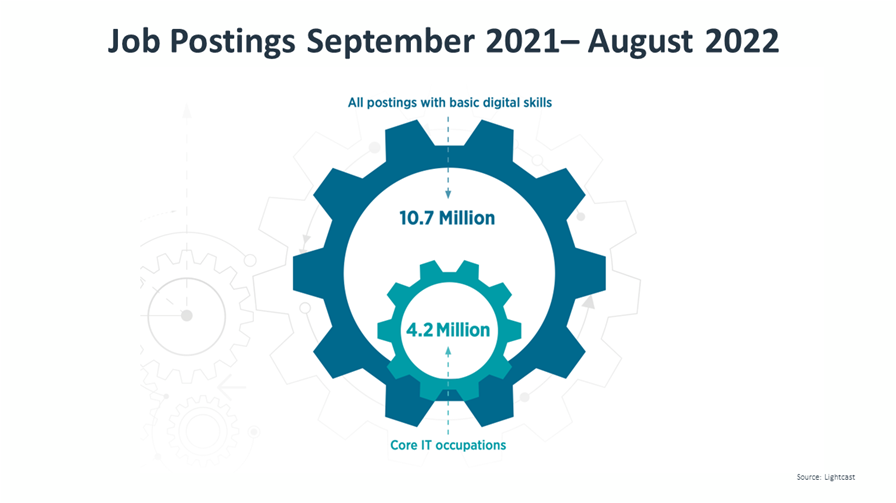
A second area to consider is the workforce. According to CompTIA’s State of the Tech Workforce report, technology was expected to account for 8.9 million jobs in the United States in 2022. This represents both those individuals working directly within the tech industry and those individuals in core tech occupations within other industries. With a labor force just over 158 million workers, direct tech occupations account for nearly 6% of the U.S. workforce.
Once again, the impact of technology extends far beyond these numbers. Examining job postings from the labor analysis firm Lightcast, there were 4.2 million job postings for core technology occupations between September 2021 and August 2022. Over that same time period, there were 10.7 million job postings requesting skills in basic computer literacy and productivity tools such as Microsoft Office. Of the top ten occupations within the 10.7 million job postings, only computer user support specialist is a core tech occupation. Other occupational categories include managers, human resources specialists and registered nurses.
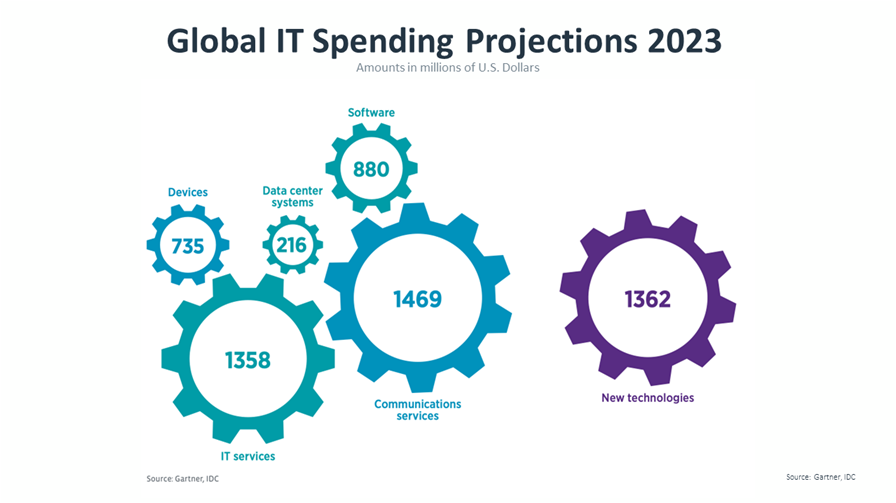
Finally, the amount organizations are spending on IT demonstrates the rapidly changing nature of technology. Gartner estimates that 2023 global IT spending will reach $4.6 trillion in 2023, a jump of 5.1% over 2022 spending. The categories included in Gartner’s estimate are traditional IT components: Communications services, IT services, devices, software and data center systems. As expected, the service categories are the largest pieces, as most organizations have built a foundational layer of computing and are now crafting new solutions on top of that foundation.
In addition to these traditional categories, emerging technology is driving additional spending. Data from IDC, which CompTIA has used in previous years, shows roughly the same level of spending in the traditional categories. IDC, though, adds a category of “new technologies,” which includes technology such as internet of things (IoT), robotics and mixed reality. Spending on new technologies is expected to hit $1.36 trillion in 2023, adding nearly 30% to the expected spending on traditional items. One final note on spending projections: The current economic chaos, including inflation and relative strength of global currencies, is impacting forecasting models as much as it is driving uncertainty for businesses. Actual spending may fluctuate more in 2023 than in previous years.
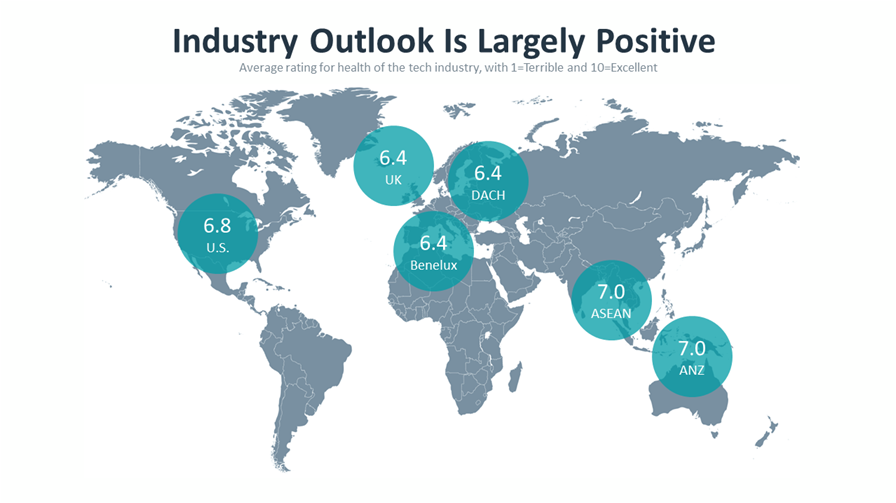
Given both the direct and indirect impacts of technology, it is no surprise to see positive sentiment toward the industry. Among technology firms in each of the six different geographic regions surveyed by CompTIA, the average rating for the future prospects of the overall technology industry skewed toward the higher end of the scale. Even with economic uncertainties and societal issues, the tech industry remains a robust choice for business growth and career advancement. For the remainder of this report, the focus is on U.S. data. Separate research briefs highlight data points from international regions.
All in all, the impact of technology today goes far beyond the technology itself. Technology is deeply ingrained into business activity and daily life. There is no question that there are some negative elements, especially as technology applications reach massive scale and trigger unintended consequences. However, there is also no question that there are many positive outcomes, and a progressive approach to technology is a critical factor for sustained success.
Caught between the recent disruption of the pandemic and the potential upheaval of a recession, technical professionals share many concerns with the rest of the workforce. However, the turmoil is not dampening spirits for IT pros. As with last year, nearly 80% of IT professionals in CompTIA’s survey report feeling optimistic about their role, including 38% who feel very optimistic. Positive sentiments are correlated with company size; 71% of IT pros feel optimistic at at small companies (less than 100 employees), compared to 83% at both mid-sized firms (100-499 employees) and large enterprises (more than 500 employees). In addition, nearly half of all respondents at large enterprises report feeling very optimistic about their role.
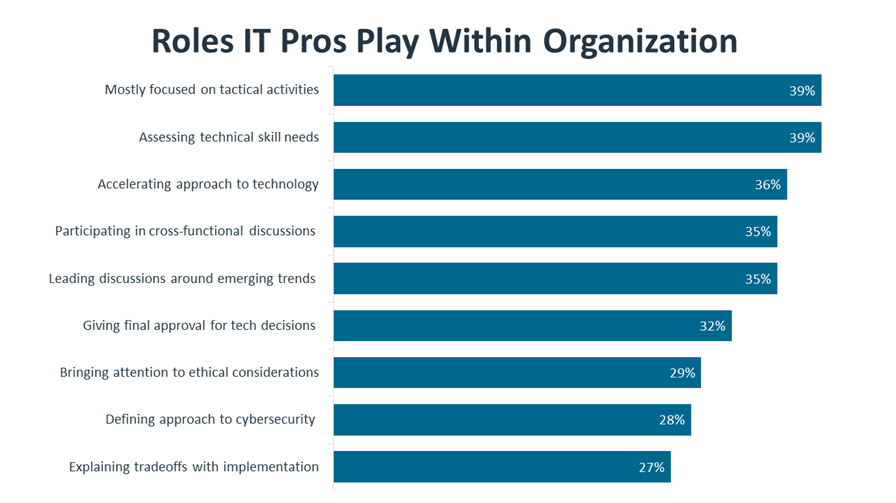
A likely explanation for higher optimism at bigger companies is the wider range of opportunities. Given the historic view of IT as a supporting function and the daily pressures that most companies face, it is no surprise to see that the top focus for most IT pros is tactical. Servers still need to be available and help desk tickets still need to be answered. Beyond this traditional role, though, there are more strategic areas for IT pros to explore, including skill assessment across the organization, improving the cultural mindset around technology and leading discussions across departments regarding technology adoption or future trends.
The profusion of opportunity is not just something organizations are doing to help their IT employees. With technology now acting as a critical component in business strategy, it is in a company’s best interest to integrate their IT specialists more deeply into operations. Of course, with most organizations making this move, the demand for skills is outpacing available supply, meaning that opportunities are open not only within an IT pro’s current employer but also in other firms that may provide higher pay or better flexibility. Over the past year, technology job postings have been plentiful and tech unemployment has been incredibly low. There is no reason to expect a huge change to the situation in 2023.
This high-demand environment is commonplace today, but it is a relatively new phenomenon for IT professionals. In the early days of enterprise technology, technical skill was not needed by most organizations. Computing was reserved for the largest companies with the biggest budgets. As technology became more widespread, the IT function was largely viewed as a cost center, and IT pros were often constrained in both resources and career progression. In today’s environment, companies are viewing IT through a strategic lens and increasing both their appetite for technology and their investment. This then leads to a high demand for skills creating a broad range of career options, which is the top reason for optimism by a wide margin.
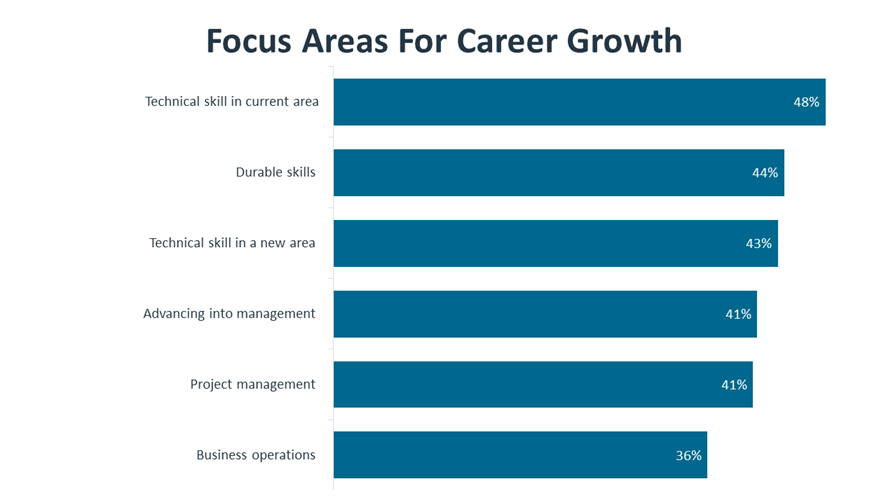
As described in the trends section, the abundance of choice opens a new set of questions. This is true for IT pros as much as it is true for companies procuring technology products and services. With many options for career advancement, there are also many options for building skills. The top choice for many technologists is to develop skill within their current area of specialization. Beyond that, durable skills such as communications or teamwork are beneficial as technology becomes more of a team sport. Rounding out the top three focus areas, IT pros may choose to explore a new area as businesses explore topics like data science or zero trust architecture. Many new job openings require a mix of various skills, and technical specialists in one field may only need to add a few new skills to become fluent in another discipline.
Whether the choice is developing skill within a current specialization or exploring a new opportunity, there is no shortage of skills needed in digital organizations. The many different facets of enterprise technology can be captured in four broad categories. CompTIA’s IT framework defines infrastructure, software development, cybersecurity and data management/analysis as the pillars supporting IT operations. At this high level, the top priorities for the coming year are software development and data management/analysis. This fits with a viewpoint of companies tailoring technology as it becomes more strategic, but that does not minimize the importance of infrastructure and cybersecurity as foundational pieces of digital transformation.
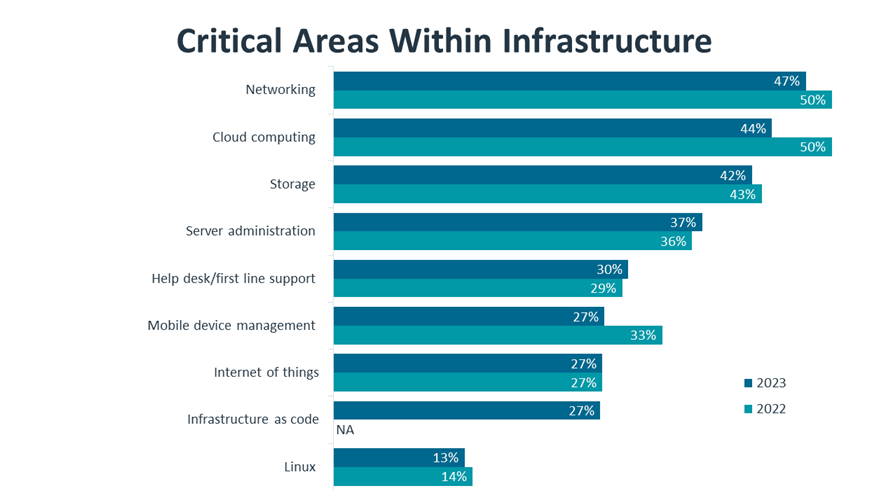
In the area of infrastructure, priorities remain fairly consistent with last year’s agenda. The ongoing maturity of cloud operations will drive demands in the areas of networking, storage and server administration. As cloud orchestration becomes more important, there will be stronger desire for more advanced skills in each of these fields. Mobile device management takes a step backward this year as there is likely less focus on equipping the workforce, and infrastructure as code (IaC) makes an initial appearance as organizations place more emphasis on software-defined data center operations.
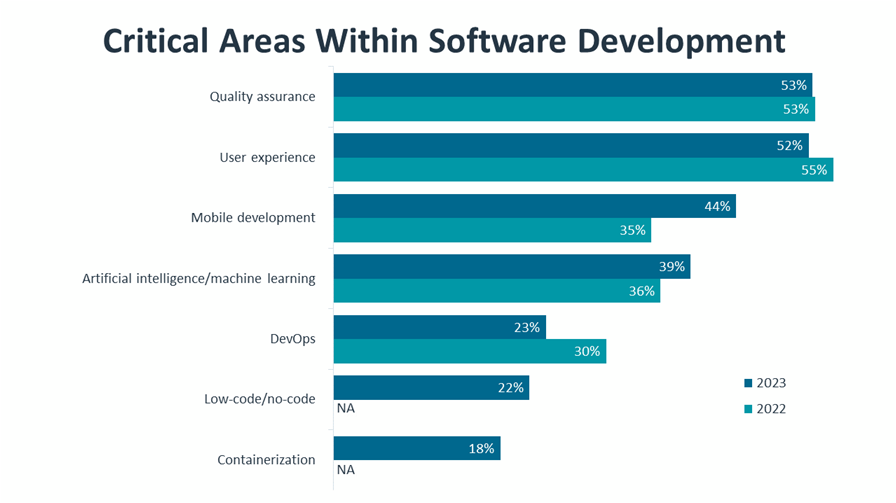
The domain of software development is also not experiencing drastic year-over-year change. As organizations expand the number of customized applications for both internal and external use, there is still a high focus on quality assurance (QA) and user experience (UX). With mobile devices steadily accounting for half of all internet traffic, optimizing digital experiences for mobile consumption continues to be important. IT pros are predicting less focus on DevOps in 2023, but this is largely because DevOps practices have now become firmly established within many firms, driving a constant demand for skill but not new investment or restructuring. Low-code/no-code solutions and containerization expand the reach of software and create more abstraction in the development process, and those areas are both expected to grow in importance in coming years.
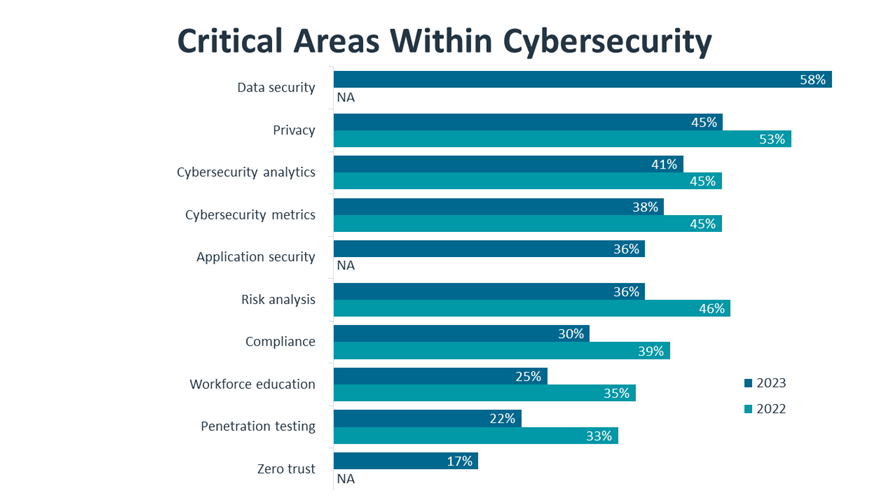
The fields of cybersecurity and data management/analysis are newer specializations for many companies, so there is more churn when it comes to focus areas. In cybersecurity, the acknowledgement of a shift away from a secure perimeter into a more granular approach is finally becoming widespread and causing policy change and upskilling need. Data security and application security were new options in this year’s survey and clearly demonstrate how companies are reimagining their cybersecurity posture. Aside from these two new areas, focus seems to be dropping across the board for cybersecurity topics. This disconnect was explored in depth in CompTIA’s 2022 State of Cybersecurity report, and it signals that companies should put more emphasis on integrating cybersecurity with organizational objectives. One specific area to keep an eye on is risk analysis. As businesses try to determine the proper level of investment for cybersecurity initiatives, risk analysis will likely be the framework guiding decisions. Along the same lines, zero trust is not currently a defined approach for many organizations, but elements of a zero trust architecture are seeing more and more adoption.
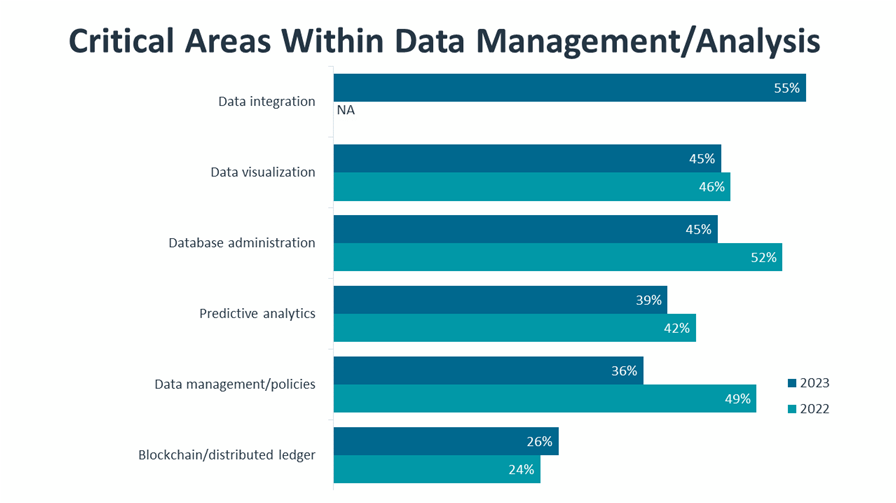
Integration is also a new concern in the area of data management/analysis. While many companies still need to focus on fundamental database administration in order to create a foundation for advanced data activities, data integration is becoming the overarching process that defines how data will be combined from various sources and made available for consumption and analysis. Analytics (and eventually data science) is still the end goal, but bringing the data into a comprehensive starting point is still a major challenge. Distributed ledger technology, such as blockchain, is slowly making inroads as an enabling technology, and it may be some time yet before the technology moves from isolated applications to broad usage within data structures.
While intent to hire is still strong (44% of companies expect to hire for technical skills in 2023), internal training remains the dominant option for closing skill gaps (64% of companies expect to train existing employees in 2023). In considering workforce development options for the next 12 months, companies may need to invest more heavily in certain components. A rigorous skill assessment can pinpoint the specific skills needed to advance corporate objectives, and it can also define training options that can target those skills. Getting closer to the actual training program, businesses can expand the types of offerings that are provided or subsidized in order to ensure the best pathways for individual learning styles.
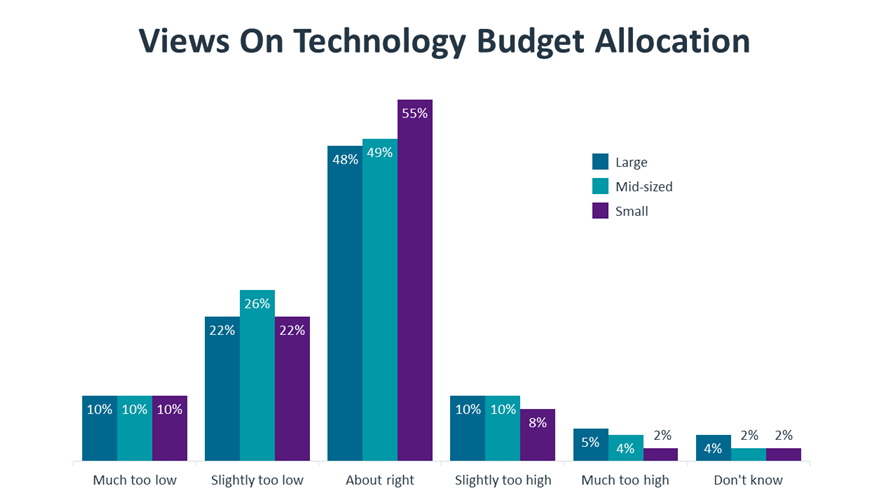
These investments for workforce development are obviously part of the larger technology budget, which appears to be stabilizing at adequate levels for most companies. As expected, the perception of technology budgets skews toward the insufficient end of the scale. Overall, though, the technology budget is healthy for most organizations, and it is moving in the right direction; 43% of companies believe that their technology budget in 2023 will be higher than it was in 2022.
At first glance, it may seem strange that any IT professionals would believe that the technology budget is too high. While there are only a small number of individuals in this category, it is worth exploring the sentiment. Given that this viewpoint is slightly more prevalent in larger firms, this may be a statement on balance. In an environment where digital transformation is held up as a new business imperative, organizations may begin viewing technology as a cure-all, opening the wallet for advanced technology purchases without making corresponding investments in best practices for usage or restructuring of business flow.
This may be exacerbated by business units making their own technology investments. When asked to consider how the overall technology budget was divided between the IT function and business units, IT professionals in CompTIA’s survey reported a nearly even split, with a slight lean toward business units. Technology procurement by business units is not necessarily a problem (and also not exactly something that can be avoided), but it does require close collaboration. A particular business function may be closest to the situation and best able to define functional requirements, but areas such as cybersecurity and integration likely fall outside the technical expertise of business unit employees.
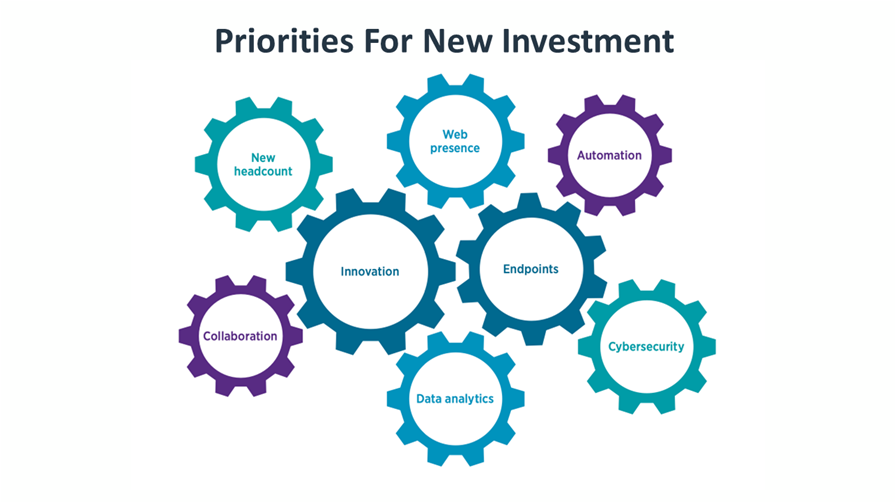
One of the most useful questions for ranking technical priorities might be the consideration of how to spend additional money if new funds became available. This leaves the field open-ended rather than focusing on an individual topic, and it still provides some degree of constraint given the financial context. Case in point: Automation ranks relatively low in this scenario, whereas most organizations give automation high marks when automation is the only topic of discussion.
The tier above automation and collaboration tools contains a mixture of wish list items. There are fairly traditional topics like web presence and cybersecurity alongside a newer topic in data analytics. The desire for new headcount shows up here, even as skill gaps are similar to automation as a top-of-mind issue in a vacuum. With these items so tightly clustered, the exact priority will depend on the specific needs of an organization.
Moving to the top tier, it is somewhat surprising to see endpoints ranked so highly. Given the large investments made to enable a remote workforce over the past two years, one might assume endpoints are up to date. This high priority speaks to the critical need of keeping the workforce productive. Minor glitches with laptops or smartphones can lead to major disruptions in employee productivity.
It is no surprise, though, to see innovation in the top slot. Whether it is investing in new products, bringing in third-party expertise or creating platforms for technology evaluation, IT professionals believe that accelerating the approach to technology will be the biggest differentiator for their organizations. Day-to-day maintenance and improvements are needed for operational progress, but the cutting edge is where potential is fully unlocked.
Innovation, like so many other things, is easier said than done. After years of a product-centric view of IT, organizations are struggling to build a new mindset around emerging technology. Rather than acting as standalone products that meet specific needs, emerging trends are more often found as enabling parts of broader solutions. The question is not so much “What can this technology do for us?” as it is “What are we doing that could be made better through technology?”
Two of the latest trends on the horizon illustrate this point. For both the metaverse and Web3, the perceptions from both IT pros and channel constituents highlight how the long-term outlook may differ from disruptive predictions. These two groups, which are the closest to technology and have navigated previous waves of emerging trends, are very aligned in their viewpoints. Most significantly, the majority opinion is that neither technology will likely be a revolutionary step forward. Instead, they will both augment digital experiences and solution architecture.
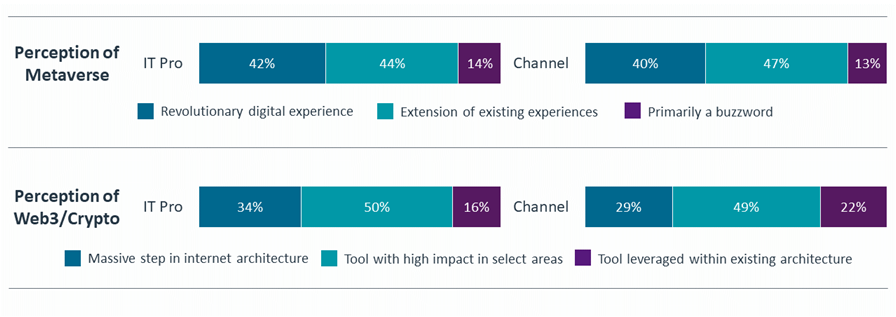
Aside from adopting a more comprehensive mindset, the challenges around emerging trends center on integration and utility. As new technology develops, standards and regulations become a defining factor in implementation, driving demand for technical skill across the entire ecosystem. In addition, building an appreciation for the strategic use case requires an overall understanding of business objectives and skill in education and marketing.
Top IT Pro Challenges for Emerging Trends
Top Channel Challenges for Emerging Trends
Much like IT professionals, companies in the business of technology (aka the channel) are starting to think bigger again, rekindling some of the strategic initiatives and aspirations that may have been put on the back burner during the extended pandemic. Yet there is trepidation as well, with many channel firms of all stripes worried about continued inflation, supply chain issues and the omnipresent threat of an economic recession. It’s a paradoxical time as we look ahead to 2023, one in which companies are at once ready to forge ahead with new investments and innovations yet must do so with a dose of caution attributable to the uncertainty of the business landscape.
This dilemma is reflected in general attitudes about the year ahead. For the most part, channel firms remain positive about their own company’s outlook for 2023, although the numbers have dipped from last year. Sixty-seven percent of respondents said they are feeling either very good or pretty good about 2023 compared with 77% that said the same last year about 2022. Instead, more channel firms have adopted a mixed attitude about how their company will fare in 2023. Twenty-four percent said they are on the fence about how 2023 will go vs. 19% that said the same last year. This sentiment reflects the guessing game situation many companies find themselves in today as they weigh new investments and hiring against continued inflation and a potential recession.
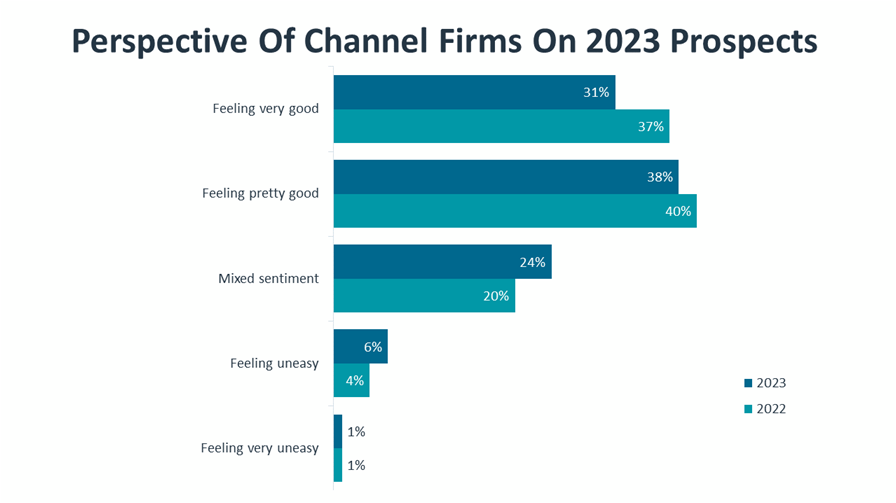
Breaking things down a bit more, channel respondents save their most pessimistic attitudes for the current state of the overall economy, compared with the IT industry and their own businesses. While 9% rate the overall economy as “terrible,” (the lowest score of 1 on a 1-10 rating scale), just 2.6% confer that dispiriting take on the IT industry and only 1% on their own businesses. There’s a disconnect, for sure, but one that makes sense based on three years of a pandemic in which other parts of the economy suffered greatly while the tech sector held its own and, in fact, thrived in many areas. Responses from the most positive end of that 1-10 rating scale bear this reality out: While 8.6% of respondents gave the overall economy a “best” or 10 rating, 12% did so for the IT industry and 15% for their own businesses. It’s important to note that these numbers reflect the two extreme ends of the scale (bad and good), while most respondents fall in the middle in their assessments of all three areas of the economy.
One of the markers that channel firms will be looking for in the year ahead is growth potential of their own business in relation to the tech industry at large. Many are bullish that growth potential is strong. Forty-five percent of respondents said they expect their own revenue and profitability numbers in 2023 to exceed those of 2022 if the tech sector flourishes. A more cautious 44% of respondents said they expect stable results on par with the year previous, even if the tech sector does well. And finally, roughly 8% said they still expect a decline in revenue and profitability even if the tech industry performs on the positive side of the economic equation. Those predictions are correlated across all company sizes, from the smallest channel firm (fewer than 10 employees) to those with more than 500 staffers.
Hedging one’s bets is normal behavior in an uncertain economy, but the reality is that the tech industry and the businesses that operate in it have opportunity galore in the year ahead. It’s a matter of unlocking that potential wisely. A few truths to consider: The industry itself is more complex and changing rapidly at both the technology and business levels. From the channel’s vantage point, that means their expertise will be in demand and greatly valued. The tech portfolio has changed immensely, too. What was once a stable set of infrastructure products on a reseller’s line card has, in the cloud age, morphed into a cornucopia of software-as-a-service applications, data and cybersecurity tools, and a stack of emerging technologies to contend with. At a business model level, everything’s in flux as companies transition into various forms of service provider, referral or influencer agent, consultant or combination of all. Finally, one of the most consequential developments affecting the channel today is the changing customer, specifically their procurement habits and technology preferences.
So, what are some of the keys to unlocking that growth and potential? Respondents cite many factors that will help lead to an optimistic performance in 2023. Leading that list is the ability to drum up business from new customers. Nearly 4 in 10 respondents said this will be critical to solid performance in the year ahead. This signals a change in emphasis from the early pandemic years when companies’ focus was on retaining and expanding business with existing customers. That pursuit is still a prominent aim (28% cited it), but more attention is being placed on building the pipeline this year. Along those lines, the third activity respondents identified as helping to drive positive results next year is tied to making improvements to and investing in both their sales and marketing functions.
 Perhaps reflecting the need to balance aggressive activities like new customer acquisition and marketing overhauls
with cost containment, the no. 2 area that channel firms believe will be needed to contribute to a more optimistic outcome next year is to improve internal operations. In other words, get more efficient. Whether that is streamlining internal processes
– something critical to a well-run managed services firm, for example – or deploying new automation technologies, the quest for operational efficiency is an ongoing component of optimal business performance.
Perhaps reflecting the need to balance aggressive activities like new customer acquisition and marketing overhauls
with cost containment, the no. 2 area that channel firms believe will be needed to contribute to a more optimistic outcome next year is to improve internal operations. In other words, get more efficient. Whether that is streamlining internal processes
– something critical to a well-run managed services firm, for example – or deploying new automation technologies, the quest for operational efficiency is an ongoing component of optimal business performance.
Rounding out the list of items companies deem essential to a positive 2023 include the successful launching of new business lines and a return to normal economic conditions that sees inflation decrease and supply chain woes abate. One could argue that these two factors are interdependent, given that a rough macroeconomy might be considered a poor environment for new business ventures. But that isn’t always the case. An attribute of many firms that weather a general economic storm well is their propensity to double down on investments in new things. And a new business line does not necessarily mean new products to sell (though it can). It could reflect a shift to a different business model, which will be discussed later in this report.
As discussed in the 2023 trends outlined in this report, inflation looms large for the channel. Among the factors that could lead to a pessimistic year ahead, continued high inflation, cited by 41% of respondents, led the pack. The remainder of the list includes 34% that cite concerns over growing labor costs and the need to find workers with the right set of skills for today’s tech world, 32% that worry about any unexpected geopolitical or macroeconomic shock to the system, and 30% that fret about customers postponing technology purchases. The cause-and-effect element of these concerns is undeniable. Increased inflation or other economic shock could beget recession, which could in turn result in layoffs that upend the labor market and curtail customer spending. Or the reverse could happen. So far, it’s been unpredictable.
One point of interest from the list of factors that arouse pessimism is the relatively low ranking of automation as a hurdle. Just 18% cite automation as a potential threat to growth in the year ahead. As elaborated in one of this report’s trends, it’s clear that automation is a development that is more positive than negative. With some caveats, of course.
Let’s talk about budgets. Much like general sentiment about prospects for the year ahead, many channel firms are making positive, yet cautious, predictions about their upcoming budgets. Compared to last year when 53% of respondents said budgets would be higher (either much or somewhat) in the year ahead (2022), a slightly lower 46% said so this year. And whether indicative of caution, pragmatism or both, 38% of this year’s respondents expect budgets to come in flat, or about the same as the year before. This compares with 26% that predicted this last year. Clearly, the economy’s uncertainty factor weighs on prognostication here, but fewer firms than last year are expecting decreases to their budget (13% vs 16%, respectively).

Thinking about what they are currently spending in various functional areas of their business, most respondents are relatively content with the amount. Roughly half of respondents said spending is “about right” for sales, marketing, operations, finance and IT at their companies.
If pressed to identify areas where spending is too low, a slight edge goes to sales, marketing and IT functions. Sales and marketing, as indicated above in this report, are considered areas to spend in 2023 to ensure growth and profitability. For many channel firms, marketing has lagged in both resource allocations and general attention. Few channel firms employ a full-time marketing staffer and the discipline itself has often been overlooked, but on the bright side, data of the last several years shows a more concerted effort around marketing and branding. Baby steps.
Interestingly, between 21% and 27% of respondents believe spending is either slightly too high or much too high across all five functional buckets. Given that respondents to the survey come from all disciplines within an organization – from the business side of sales, finance and marketing to technical employees to managers and business owners – this parity of agreement is somewhat novel. Again, the unifying driver may be economic uncertainty as we enter 2023. Every job role within an organization might be looking for ways to save money, reduce costs, etc.
All that said, channel firms have their spending priorities for the year ahead. Some of them reflect strategic external initiatives, others the fuel for operational improvements on the inside. Call this the yin and yang that comprise a high-performing company.
Topping the list is updating and modernizing current infrastructure, which 35% of respondents identified as a spending priority. This is an interesting one given that infrastructure improvements have been a focus area throughout the span of the pandemic, when many companies throttled back on new endeavors and instead spent time and money shoring up their own operations, as well as refreshing the basics for their customers. Clearly, that mission is not complete.
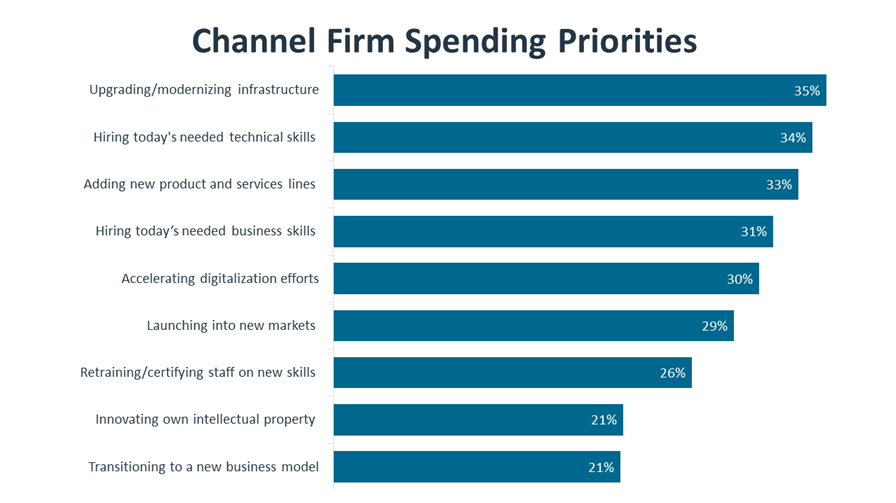
On par with infrastructure improvements in terms of spending priorities is hiring staff with the right technical skills for today’s digital world, which 34% of respondents cited, as well as adding new product and service lines of business, which 34% identified. The workforce issue is perennial, but critically important. As companies jockey against competition, they will need to up their game by hiring employees skilled in job roles in demand, such as those in data, cybersecurity and emerging trends. Software acumen, specifically development skills, will also play a larger role in the channel’s typical talent needs in 2023. Spending priorities aren’t just centered on the technical workforce, though. Thirty-one percent of channel firms said they will spend to seek skilled sales and marketing employees in the next year. This would include sales reps that are adept at selling services and consulting contracts, along with marketing professionals with expertise in social media and other omnichannel approaches to customer communications.
Speaking of customers, understanding their needs, spending priorities and constraints is a crucial ingredient for channel success in the new year. For years now, the industry has seen a slow but steady shift in who holds the purse strings when it comes to technology decision-making and procurement. More and more line of business executives today own tech budget and routinely make critical purchasing decisions for their departments and staff – both with and without the involvement of an internal IT department. This has necessitated change within channel firms seeking to work with these customers, especially with respect to sales techniques and activities, as well as marketing messaging and the choice of conduits for communication.
Channel firms rely on some approximation of what customer budgets for technology look like each year. It’s been a crapshoot of forecasting for many firms during the pandemic, especially those that count the small end of the SMB market as their primary customers. Those SMBs were hard hit during the pandemic and their tech spending in many cases dropped off. Still, patterns were unpredictable. For some customers, the unforeseen remote work migration forced a wave of spending on devices, Wi-Fi and other virtual communications apps. Still others turned to the services of an MSP for the first time ever.

Diving into the data, channel respondent predictions for customer spending on technology in 2023 mirrors nearly exactly what they saw for real in 2022. That’s a safe assessment on their part, again likely reflecting the economic unknowns ahead. Depending on how things go with inflation and other economic variables, customer spending on technology could surge past or retreat from these predictions.
What is completely clear is that everyone today is a potential customer of technology. Consider the following: 17% of channel firms said they sell to a business owner/president, 26% sell to business executives, 31% sell to an IT department person and 26% sell to all three. This means the days of speeds and feeds tech talk as the main sales call vernacular to the IT guy are largely over. Buyers today want a channel provider that has unique knowledge of their business mission, operational needs and goals. The shift in conversation toward business outcomes is a learning curve for many channel firms, but the skill will be essential moving forward as part of overall improvements to customer experience and sales effectiveness.
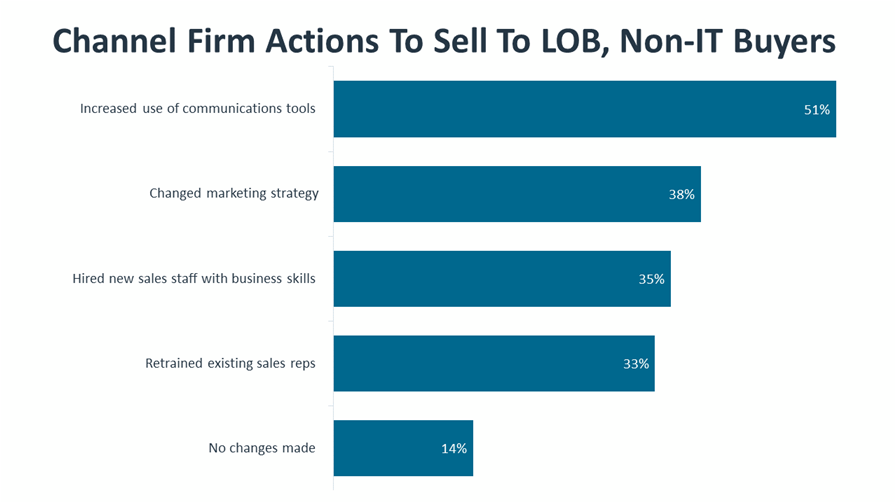
Business models are changing for the channel just as the customer is. For years, we have been hearing about and witnessing a slow march from traditional reseller of hardware to full-portfolio solution provider to managed services provider. That is very much still happening. But the drumbeat for business model change seems louder today, largely driven by a digital-everything economy, cloud computing, hardware commoditization and margin erosion, and direct procurement competition from online marketplaces and vendors.
Business model change can mean many different things to many different channel firms. A small tweak such as adding a vertical specialty, for example. Or a major transition from a product reseller to a company that does pure IT consulting. Whatever it happens to be, most channel firms today report some degree of business model change or active consideration of starting one.
Twenty percent of respondents said they have already undergone a change to their business model in the last few years; 35% are in the middle of one; and 32% are currently exploring one but have not yet started. Just 11% said that no business model talks are on the table at this time. Larger firms are ahead of their smaller brethren in terms of completed business model shifts, not surprising given their access to greater financial resources and the ability to pilot project new initiatives while keeping their original business going. Small firms typically just can’t do that. That said, a net 68% of micro- and small-sized channel respondents said they were currently undergoing a business model transition.

What do these business model changes look like? For the most part, they are variations on a theme: The move to recurring revenue and services. But the flavors are nuanced. Here are the top five business model shifts respondents reported:
This journey to recurring revenue and, most importantly, services has been ongoing. But today’s realities have elevated the urgency of moving faster. More customers buying directly from online marketplaces has many in the channel scurrying to find their competitive play when they no longer own the initial transaction. That play takes the form of pre- and post-sales services, including work around integration, cybersecurity, compliance and ongoing management of the customer environment.

And let’s not forget the financial piece of the picture. Services are lucrative, certainly more profitable than hardware sales today. They also bond channel firms to their customers, whether through ongoing project work or managed services. This customer stickiness and familiarity has been one of the channel’s greatest assets over the years. It’s also one that holds up during the ebbs and flows of an uncertain economy.
This quantitative study consisted of two online surveys fielded to business and IT professionals during September/October 2022. A total of 500 professionals based in the United States participated in each survey, yielding an overall margin of sampling error at 95% confidence of +/- 4.5 percentage points. For international regions (ANZ, ASEAN, Benelux, DACH and UK), a total of 125 professionals in each region participated in each survey, yielding an overall margin of sampling error at 95% confidence of +/- 8.9%. Sampling error is larger for subgroups of the data.
As with any survey, sampling error is only one source of possible error. While non-sampling error cannot be accurately calculated, precautionary steps were taken in all phases of the survey design, collection and processing of the data to minimize its influence.
CompTIA is responsible for all content and analysis. Any questions regarding the study should be directed to CompTIA Research and Market Intelligence staff at research@comptia.org.
CompTIA is a member of the market research industry’s Insights Association and adheres to its internationally respected Code of Standards and Ethics.
The Computing Technology Industry Association (CompTIA) is a leading voice and advocate for the $5 trillion global information technology ecosystem and the estimated 75 million industry and tech professionals who design, implement, manage and safeguard the technology that powers the world’s economy. Through education, training, certifications, advocacy, philanthropy and market research, CompTIA is the hub for advancing the tech industry and its workforce.
CompTIA is the world’s leading vendor-neutral IT certifying body with more than 3 million certifications awarded based on the passage of rigorous, performance-based exams. CompTIA sets the standard for preparing entry-level candidates through expert-level professionals to succeed at all stages of their career in technology. Through CompTIA’s philanthropic arm, CompTIA develops innovative on-ramps and career pathways to expand opportunities to populations that traditionally have been under-represented in the information technology workforce.
Read more about IT Workforce, The Business of Technology.